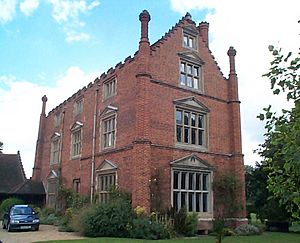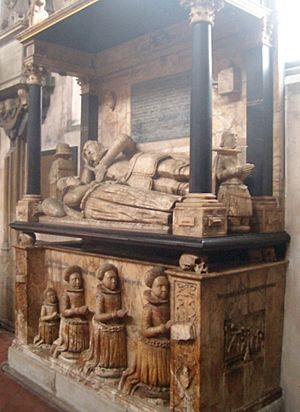John Suckling (politician) facts for kids
Sir John Suckling (born in 1569, died in 1627) was an important English politician. He served in the House of Commons, which is like the main law-making body in England, at different times between 1601 and 1627. He held many important jobs in the government during the reigns of King James I and King Charles I.
Contents
Early Life and Family Background
Sir John Suckling was the son of Robert Suckling. His father was a well-known person too, serving as the mayor of Norwich. He was also a Member of Parliament for Norwich. Sir John's mother was Elizabeth Barwick.
In 1590, John Suckling began his studies at Gray's Inn. This was a place where people learned about law.
A Career in Politics
Sir John Suckling started his political career in 1601. He was elected as a Member of Parliament (MP) for a place called Dunwich. An MP is someone chosen to represent a specific area in the House of Commons.
Working for the King
In 1602, Sir John worked as a secretary for Sir Robert Cecil. Sir Robert was the Lord High Treasurer, a very important role in charge of the country's money.
Later, in 1604, Sir John took on a new job. He became the "receiver of fines on alienations." This meant he collected money from certain legal payments.
In 1614, he was elected as an MP again, this time for Reigate.
Becoming a Knight and Royal Official
King James I honored Sir John Suckling in 1616. He made him a knight, which meant he was given the title "Sir."
Sir John continued to rise in the government. In 1619, he became a Master of Requests. This job involved handling petitions and requests made to the king.
By 1622, he was appointed Comptroller of the Royal Household. This was a significant position, helping to manage the king's personal expenses and staff. Sir John was quite wealthy by this time. He owned many properties and lands across the country.
High Government Roles
Sir John Suckling's career reached even higher levels. In 1621, he was considered for the job of Chancellor of the Exchequer. This person is in charge of the country's finances.
In 1622, he was promoted to Secretary of State. This was a very powerful position, dealing with important government matters and foreign affairs.
When Charles I became king in 1625, he made Sir John a Privy Councillor. This meant he was a trusted advisor to the king.
Representing Different Areas
Sir John Suckling was a popular choice for MP. In 1624, he was elected to represent three different areas: Middlesex, Lichfield, and Kingston upon Hull. He chose to serve for Middlesex.
In 1625, he represented Yarmouth (Isle of Wight). The next year, in 1626, he was elected for both Norwich and Sandwich. He decided to sit as the MP for Norwich.
Family Life
Sir John Suckling was married twice.
First Marriage
His first wife was Martha Cranfield. She was the sister of Lionel Cranfield, 1st Earl of Middlesex, another important person in government. Martha passed away in 1613 when she was 35 years old.
Sir John and Martha had a son who became famous. This was the poet Sir John Suckling. You can see a monument dedicated to Sir John Suckling, his first wife Martha, and their family in St Andrew's Church, Norwich.
Second Marriage
After Martha's death, Sir John married Jane Hawkins. She was a widow from a family in Suffolk.
After Sir John Suckling passed away, his widow Jane married again. She took the estate of Roos Hall into her new family. Sir John had bought Roos Hall in 1600 to be his home. Although it was briefly owned by someone else after his death due to a debt, the Suckling family later bought it back.



